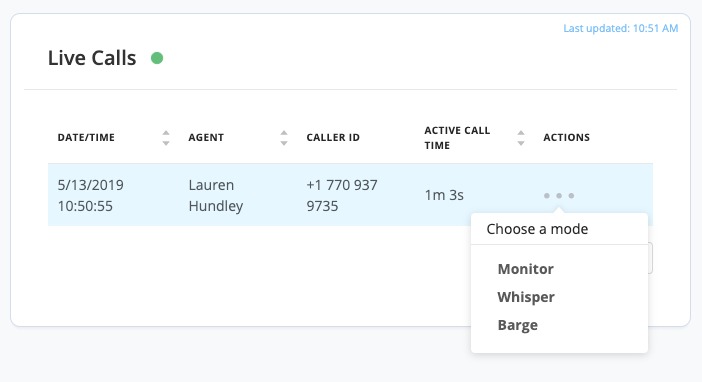Customer Service Etiquette: How to Speak to Customers in the Call Center
Trying to establish rules and procedures that lead to excellent etiquette in your call center? Learn the best practices for handling calls and speaking to customers in the call center.
Establishing great customer service etiquette standards is one of the most important things you can do for your brand reputation. Oftentimes, a phone call made to customer service is a person's only live interaction with your business. That means the majority of your brand perception is defined by your call center agents' phone etiquette!
If you want to improve your call center's customer service experience, we're here to help! AVOXI has been in the business of improving call center team performance for nearly 20 years with better customer service call center software. Today we're sharing some of the common tips and tricks we see working for most customer service teams. In this article, we'll cover:
- Important etiquette rules you should set in your call center
- Strategies for better call center etiquette training
- Our top 5 customer service etiquette tips
- Suggestions for your call center etiquette tests
If you find this article helpful or have suggestions for how we can make it better, please let us know! The purpose of this article and others like it is to be a useful resource for you, so we appreciate any feedback.
Rules of Etiquette in the Call Center
Call center etiquette can seem pretty self-explanatory however it never hurts to have a little refresher. Below are some of the most important phone etiquette tips for agents when talking with customers.
Basic Rules When Speaking with Customers
What better place to start than with the basics. If you already have the basics down then you are just one step closer to having ideal call center etiquette, but if not here are some of the most important rules!
- Always introduce yourself and the company
- No gum chewing
- Speak clearly and directly into the phone
- Don’t cover the phone - put on hold if you need to ask another employee a question
- Answer the phone ideally within 2-3 rings
- Greet the caller according to your companies script
- Use an appropriate tone of voice and pace when speaking to a customer
- Be professional
Proper Hold Procedures
Nobody enjoys being on hold but sometimes it is unavoidable. Here are some tips on how to properly place someone on hold and still create a good customer experience.
- Ask the caller if it is okay to place them on hold and wait for them to say it's okay
- Give them the choice to be called back or if they prefer to stay on hold if the solution is going to take a while
- Check back in every 30 seconds or so with the caller on hold
- Always thank the caller for being patient
Rules When Transferring a Call
Transferring a call properly is especially important. Improperly transferring a call can waste customers' time making them more irritated than they were at the beginning of the call.
- Inform the caller as to why they are being transferred
- Explain why it is in their best interest to be transferred
- Check to make sure the person/department is able to take the call before completing the transfer
- If the call cannot be transferred get all of the caller's information and inform them that someone will give them a call at their earliest convenience
- If the call can be transferred make sure the new department/person has the callers name, request, and any other helpful information they might need to assess the issue
- Consider a policy where your reps stay on the call after they transfer it to a technician so they can see how the issue was resolved. This increases the likelihood that they will be able to handle the call on the first touch when the same or similar case comes up again.
Call Center Etiquette Training
Every job requires some sort of training and proper call center etiquette isn’t any different. There are several different training mechanisms to help your agents perform their best.
1-On-1 Agent Training
The first step to properly educating your call center agents is to learn what they already know.
- Have agents go through mock calls and observe how they would respond to the callers (paying close attention to the tone of voice, mannerism, and response times)
Mentor Training
After establishing their experience level pair them with a veteran call agent that will have the most impact on their skillset.
- This gives them first-hand look as to what the company expects from them
- It is an easy way to learn tips that will help them be successful when handling callers
Live Call Training
There are several different live call training methods such as live call monitoring, call whisper, and call barge.
Live Call Monitoring: This tool is used to listen to the conversations your agents are having with the customers without them knowing. This non-negotiable quality assurance practice is a great way to gather information on how your agents are performing. Live call monitoring can be more accurate than just referring to your metrics dashboard.
Call Whisper: Similar to live call monitoring, call whisper is another tool used to listen to conversations between agents and callers. The difference is that the agent knows you are there. Call whisper is a great tool to use especially when handling difficult customers. A supervisor or manager can simply walk the agent through the call and give them tips on how to handle a difficult situation without the caller knowing they are there.
Call Barge: This tool is used as a last resort. If you notice your agent incorrectly handling a situation and you are about to lose a customer you can take over the call completely to reassess the situation. It's important to discuss with the agent why you barged their call. Another important point to make is that overusing this tool can lead to a negative effect on the agent's performance.

Testing & Monitoring Agent Etiquette in Call Centers
You have completed the training sessions with your agents, now its time to see what they really learned. Your training is only successful if your agents are implementing what they learned when handling customer's needs. Call center etiquette tests are a great way to evaluate your agent's performances. They are an easy way to track metrics and discover trends within your agents. The tests can be administered two different ways, through online exams where the agent simply goes through and answers a series of multiple-choice questions or through live testing. Live testing would require a manager or supervisor to listen in on the call through live call monitoring and take notes on what the agent is doing correctly and what they might need some more work on.
Multiple choice quizzes can be helpful in the beginning to learn what level of experience the agent is on however it is important to combine it with live call testing. While the agent might know the correct answer, clicking the best answer choice is a lot easier than actually implementing the behavior with a caller. Live testing should be implemented on a routine basis. An example of a schedule might look like:
- Once a week for the first 6 weeks
- Once every 2 weeks for the next 8 weeks
- Then once a month for 3 months, etc. or as it seems fit
*If they receive a score of over 85% on call etiquette you can reduce the live testings, and if their score doesn’t seem to be improving or begins to go down it might be a good idea to have the agents go through some additional training.
Using customer service scorecards in your call center is one of the most important practices a manager can exercise. For more information about call center agent scorecards, we've gone into great detail and even included downloaded customer service scorecard templates here.
5 Rules for Awesome Phone Etiquette
1. Body Language is Important when Speaking on the Phone
You might be thinking "well, they can't see me, so why does my posture matter?" Interestingly enough your posture can really affect the way you conversate with the caller. If you are working from home, sprawled out on the couch taking customer calls you are going to sound unenthused and uninterested. If you are sitting up straight at a desk you are going to be more motivated to help assist the caller with whatever they need.
2. Don't Even Think About Interrupting a Customer
It can feel like a waste of time listening to someone go on and on about an issue you simply cannot solve. However, instead of cutting the caller off mid-sentence to inform them that you are going to transfer them to someone who is more inclined to help them it is important to listen to their entire complaint. Actively listening to customers makes them feel valued, and will result in a higher customer satisfaction rating.
3. Ask Before You Act
Before placing a caller on hold or transferring them to a different department it is important to ask the caller if it is okay first. The caller's time is incredibly valuable and by asking them first it makes them feel as if they have a say in the conversation.
4. Always Inform Your Customers
Your customers should know what is going on at all times. While one of the key performance indicators of customer support-faced call centers is resolving the issue with one phone call, sometimes that isn't always the case. Ensure that the customer is informed of the following steps that will be taken to resolve their problem. Make sure that you give the team working on the conflict plenty of time to resolve it, and keep the customer in the loop with updates on the progress being made. By giving the customer updates it lets them know that you haven't forgotten about them. This leads to a happier loyal customer, quickly turning a negative situation into a positive one.
5. Handling Angry Callers
Working in a call center can be especially challenging when you have an angry customer to deal with. It is important to enroll each agent in a conflict resolution training course and soon handling a difficult customer will be nothing! There are seven key things to remember when handling an angry customer:
- First impressions are important
- Be empathetic
- Speak clearly
- Keep your composure
- De-escalate the situation quickly
- Follow-up afterward
- Always use your resources
For more on this, we've gone into further detail about managing difficult customers on the phone.
Customer Service Etiquette Do's and Dont's
Having great customer service can mean all the difference in returning customers. While how to properly treat a customer might seem obvious, there are some extremely important do’s and don’ts to always remember if you want to have a great customer service reputation.
Honesty
Do: Always be honest with your customer, especially with the time-frame set to have their issue resolved. Being honest and explaining the procedures that will be taken to solve a conflict will gain a lot more respect with the customer.
Don't: Lie and say you will have their problem solved in 5 days when you know the agent assigned to fix the problem is relaxing on a beach for the next three days enjoying their PTO.
*Always give your team extra time in resolving a problem to account for any unexpected issues. The customer will have no issue with their problem being resolved quicker than expected, but if you have to extend the time for their resolution you will run into some issues and a very unhappy customer.
Respect
Do: Put yourself in their situation and make sure that you are treating the customer with the highest level of respect. Work with the customer as best as you can to create a swift, enjoyable experience.
Don't: Make the customer feel as if their time isn't valued, there are plenty of other things they would rather be doing than calling you about an issue.
Responsibility
Do: Whether or not the problem the customer is calling about is your fault you take responsibility. The caller does not care who is at fault only that the issue be resolved as quickly as possible.
Don't: Talk poorly of anyone in your company or any other department, as a customer service representative or call center agent you become the face of the company’s brand
*It is easy for people to like a company when everything is going smoothly but ensuring a great experience when things aren’t will go a lot further for your companies reputation.
Keep It Simple
Do: Simplify the problem at hand and make sure you understand your audience.
Don't: It's important to not use complicated tech jargon if your customer isn't going to understand it. The last thing you want to do is make the customer feel dumb for not understand what you are trying to say.
Listen
Do: Listen to what your customer is saying. There is a good chance they are going to give you honest feedback as to how their experience went. Use it to make to your advantage to make the next call you have with a customer even better. You can also use the feedback to build relationships with the customers.
Don't: It is important to use the feedback you are given constructively and not take it personally. Don’t forget how important it is to turn a caller's negative experience into a positive one.
On-Demand Webinar
Call Volume Spikes in Your Contact Center: How to Go from Surviving to Thriving
Learn just how AVOXI and Hyatt are managing call volume spikes in their call centers every day.

Download Your Free Scorecard Templates
Handle Calls with Etiquette in Your Contact Center
Take control of your agent performance and gain better visibility into your call center conversations today! With Call Insights and Live Call Monitoring dashboards in AVOXI, you can drive better training and protocols in your contact center.
